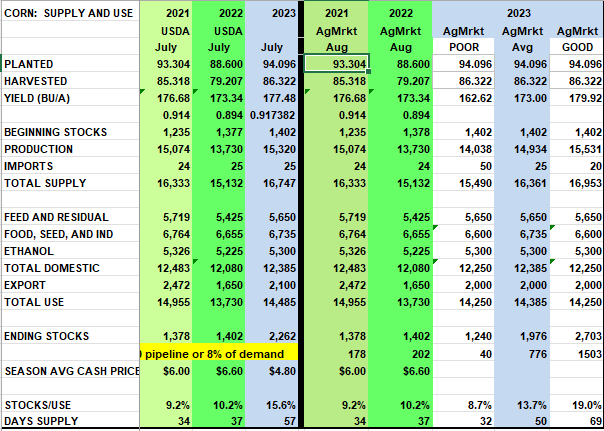
This is the time of year grain trading becomes difficult. The market seems to move dramatically on changes in agronomic perception.
According to Kenan Layden, AgMarket.Net’s Agronomist Consultant and Broker, “Corn is susceptible to potential yield loss due to stress from pollination through the R5 dent stage. Major yield loss during pollination through the R2 blister stage is estimated at 3-9% of the yield potential per day. This is when kernels are most susceptible to abortion from stress. If the corn plant is under stress from the R3 to R5 stages, similar yield losses will occur at each stage, gradually declining through each subsequent stage. Losses of 3% per day during these stages have been estimated by research universities.”
So the 100 F degree heat is VERY problematic in drier subsoils. According to Jim McCormick, another AgMarket.Net colleague, “As of July 18, approximately 55% of the corn belt has subsoils that are concerning.” That percent of growing area has traders on edge.
What about soybeans? “Soybeans are plants with a high degree of plasticity,” Layden says. “They are great at regrowing from damage and adding more pods if growing conditions improve. This plasticity decreases when soybeans hit the R4 full pod stage.” Thus the crop has more time and maybe weather will improve. Jim McCormick says, “with 50% of the bean ground subsoil short, and the recent reduction of bean acres reported by NASS, traders could react aggressively if the weather does not improve in the next 3-4 weeks.”
Here is the end stock difference between a realistic yield and then a yield that reflects extreme losses.

USDA numbers are on the left side of this table and AgMarket.Net numbers on the right. A 173 bu. yield, which is well below USDA’s 177.48, still reflects a 1.976 million bu. ending stocks. But if yields fall to the next standard deviation, a 162.62 yield generates a pipeline end stocks of just 1.240 mb.
The big debate is demand.
Realistically, USDA and AgMarket.Net demand numbers are overstated by as much as 750 million bushels. However, with the Ukraine and Russian war now hitting export capacity, we (and probably USDA) will keep the larger potential demand until we see a more stable export environment.
But this is an important fact to think about. If demand doesn’t show up in the midst of all this bullish news, we must lower demand significantly and that will raise ending stocks regardless of yield or price. In other words, this table probably reflects the most Bullish scenario, and it is not really bullish unless yields fall below 170 and head toward 162.
Corn strategies
If your farm looks like a good yield is in the making, use the current bullish weather and war rally to sell. World stocks are not going to be affected as dramatically as the U.S. because the large South American production and prospective 2023-24 acres.
We challenge you to revisit your Profit/loss statement. At these prices, the profit on 2023 and next year’s 2024 crop should be secured using a flexible position that allows you to participate in a rally but protects your back in a sell off.

Soybean insights
Soybeans still have three to four weeks to be ‘saved’ so the ‘what-ifs’ are more difficult. The lower acreage number puts more emphasis on yield performance. A 52 bu. yield is a no brainer, no problem environment. But the next deviation, or a 49.55 bu. yield, would not even meet pipeline requirements and the market would be forced to ration.
Often when demand is faced with a shortage, there is a rush to get stuff bought - the “oh poop, the hurricane is coming we better buy water and food” effect. So time will tell.
We should also point out that our demand numbers are higher than USDA. We are doing this so we can monitor the “what-if” economic effect of reduced yield more effectively if in fact yields fall off.
If yields are good, the market is bearish regardless of our demand being too large or reducing it to USDA numbers. But it also tells us that if soy yields are near or below 50 bpa, there could be a need for the market to ration demand or shift demand to South America. That can happen with a rally in U.S. prices or a fall in South American prices.
Brian Burke, President of JSA and cash market expert, says FOB Brazilian beans are -67 cents cheaper than U.S. for spot, -63 cheaper for August, -67 Sept, and about even for October. So we are the “fill in” marketplace for buyers until fall.
Watch weather and Profit/loss per acre. If profits are there, sell cautiously and use options to protect your backside. You can reach us at 844-4Ag-MRKT or 844-424-6758, or visit our website for a free 30-day trial for any of the 23 reports we distribute to clients.
The risk of loss in trading futures and/or options is substantial and each investor and/or trader must consider whether this is a suitable investment. AgMarket.Net is the Farm Division of John Stewart and Associates (JSA) based out of St Joe, MO and all futures and options trades are cleared through ADMIS in Chicago IL. This material has been prepared by an agent of JSA or a third party and is, or is in the nature of, a solicitation. By accepting this communication, you agree that you are an experienced user of the futures markets, capable of making independent trading decisions, and agree that you are not, and will not, rely solely on this communication in making trading decisions. Past performance, whether actual or indicated by simulated historical tests of strategies, is not indicative of future results. Trading information and advice is based on information taken from 3rd party sources that are believed to be reliable. We do not guarantee that such information is accurate or complete and it should not be relied upon as such. Trading advice reflects our good faith judgment at a specific time and is subject to change without notice. There is no guarantee that the advice we give will result in profitable trades. The services provided by JSA may not be available in all jurisdictions. It is possible that the country in which you are a resident prohibits us from opening and maintaining an account for you.
The opinions of the author are not necessarily those of Farm Futures or Farm Progress.
Read more about:
WeatherAbout the Author(s)
You May Also Like






